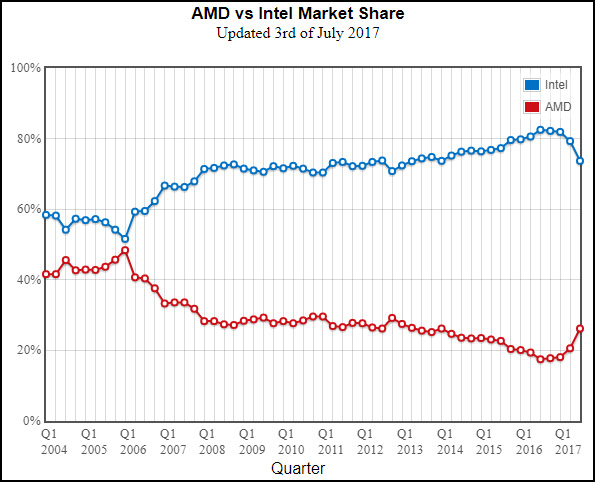AMD Ryzen Makes Significant Progress Capturing Share Of Desktop Processor Market Versus Intel
System builders—both professional and do-it-yourself types—have been waiting a long time for AMD to be competitive again with Intel. Over the years, each new architecture launch from AMD seemed to come with big promises that would ultimately turn out to be empty, but then Zen came along. Finally, AMD built an architecture that lived up to the hype, and with Ryzen getting off to a strong start, it appears the chip designer has been able to chisel away at a not-so-insignificant chunk of Intel's market share in the enthusiast market.
We can see this by examining the market share figures collected by Passmark based on thousands of PerformanceTest benchmark results. While not a definitive measure of market share, there is more than a decade's worth of data to comb through, which Passmark neatly assembled into a graph show how things have shaken out over the years. Its newest report shows that AMD is starting to close the gap somewhat. Have a look:

Source: Passmark
So, what does this data tell us? In the first quarter of last year, just 20.1 percent of tests were performed on AMD hardware, versus 79.8 percent on Intel chips. The gap widen by the end of the year, with AMD accounting for 17.8 percent of all tests run through Passmark's software, with Intel jumping up to 82.2 percent.
Fast forward to the quarter than just ended and things are looking a bit different. AMD's share has climbed to 26.2 percent, while Intel's has slipped to 73.7 percent. Obviously Intel is still dominating, but what this shows us is that AMD was able to take a nearly 10 percent chunk out what is probably the enthusiast market from Intel. The reason we believe this is largely relegated to the enthusiast market is because AMD's Ryzen architecture is brand new, and that would be the most logical explanation as to why its numbers have suddenly spiked at the expense of Intel.
Granted, we're working with a limited data set here—the numbers represent data gathered from a single benchmark. But what makes this a relevant snapshot is the running tally. The same method has been used for years, allowing us to see the trend between AMD and Intel. And what that trend shows us is that AMD is fashionable again.
It will be interesting to revisit this in another quarter or two, as both AMD and Intel are targeting enthusiasts with higher end processor options—Threadripper for AMD, and both Kaby Lake-X and Skylake-X (Core X Series)for Intel. Threadripper looks to be another promising launch from AMD, both in terms of cost and the number of available PCIe lanes, which could prove to be a big advantage over Intel's offerings.

